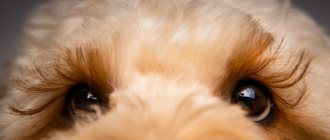When a dog's eyes water, this is not always a warning sign. Slight tearing of the eyes is characteristic of certain breeds and is normal. There are other, more serious causes of wet eyelids. What factors can cause tears from the eyes, what care is needed, what is the treatment? We will answer these questions in our article.
Breed characteristics
In the huge family of canines, there are dog breeds for which teary eyes are a completely normal phenomenon. Brachycephals with a flattened muzzle, long-haired individuals, and those with a large palpebral fissure walk with perpetually wet eyes. Discharge from the eyes is considered normal for them and does not require special treatment, just competent care. The list of breeds includes:
- Saint Bernard;
- bulldogs;
- Bloodhound and Basset;
- chow-chow;
- Cocker Spaniel;
- many decorative breeds (Yorkies, Pekingese);
- Shar Pei;
- bullmastiff;
- Great Danes.
When is rinsing required?
Washing is performed not only for preventive purposes, but also for therapeutic purposes. In the first case, the frequency of the procedure depends on the characteristics of the pet, and in the second, on the recommendations of the veterinarian.
Daily procedure
The appearance of colorless or pale gray discharge in the corners of the eyes after sleep is absolutely normal. Accumulating liquid indicates the correct functioning of the lacrimal apparatus. It is removed as needed, but at least once a week. More frequent cleaning is necessary for the following breeds:
- Pekingese, pugs and chihuahuas with bulging eyes;
- lap dogs, Yorkies and Shih Tzus with too long hair on the face;
- spaniels, sharpeis and basset dogs with drooping eyelids;
- boxers, bulldogs, Japanese chins and other brachycephalic dogs with a shortened and flattened muzzle.
Older dogs are also at risk. With age, the production of tear fluid deteriorates, so a pronounced dullness appears on the cornea. Lack of regular hydration and rare cleansing are fraught with the development of chronic conjunctivitis and even blindness.
In case of illness
When the visual organ is damaged, the body activates a protective function. This is accompanied by an increase in the amount of tear fluid and the onset of the inflammatory process.
The presence of pathogenic microflora can be recognized by the consistency and color of the discharge. The liquid that accumulates in the corners becomes cloudy and turns yellowish-green or brown. When dry, it sticks together the eyelids and eyelashes, preventing the eyes from opening easily.
Depending on the cause of the disease, the veterinarian prescribes antibiotics, anti-inflammatory and other drugs. To increase their effectiveness, pre-rinsing is necessary. Otherwise, the medicine will not be able to distribute over the entire surface of the eye.
What causes watery eyes?
If a four-legged pet is not one of the breeds for which increased tearfulness is considered normal, then its manifestation should alert the owner. The reason for deviation from the norm may be:
- Allergy. If it is caused by food, then the eyes begin to itch and water. With an allergic reaction to pollen or dust, sneezing is added to the first two symptoms.
- Injuries. Minor injuries to the cornea and eyelids cause irritation of the mucous membrane and increased tearing. Deep wounds are more noticeable, but they are also more difficult to heal.
- Foreign body. The speck gets behind the eyelid and creates a friction effect, which leads to irritation. In an effort to eliminate the obstruction, the dog’s body stimulates increased secretion of moisture in the eye.
- Consumption of sweets. The dog's digestive system cannot absorb glucose. The entry of sugar into the animal’s body causes serious disturbances; against the background of disruptions in the gastrointestinal tract, tearing appears.
- Infectious diseases. For some of them, for example, canine distemper, increased discharge from the eyes is considered one of the characteristic symptoms.
If there is an injury or a foreign body, excessive tearing may occur in one eye.
Preventive measures and care
To prevent conjunctivitis, good eye care for your Yorkshire Terrier is essential. The main thing is to properly care for your dog and comply with sanitation and hygiene standards. The place for the animal should be dry, clean, the bedding for the Yorkie should be replaced (every 10 days).
Any pet can get conjunctivitis. But if you give him first aid and go to the veterinary clinic in time, complications can be avoided.
Symptom of tearing in eye diseases
When answering the question of why a dog's eyes are watery, eye diseases should also be included. These include:
- Conjunctivitis, which occurs for a variety of reasons. Eye injury, infection, or a cold can trigger this disease.
- Turning of the eyelids. Normally, the edges of the eyelids fit loosely to the eye; when inverted, they turn inward. Skin hairs and eyelashes touch the cornea, rub against it and irritate it, which leads to the release of tears. An operation is performed to eliminate the defect.
- Eversion of the eyelids. With such a defect, the eyelid turns strongly outward, the lacrimal lake does not cover the lacrimal punctum, and the accumulated moisture freely overflows over the edge of the eyelid.
- Blepharospasm. The animal squints its eyes, the eyelids are tense, the dog blinks frequently. Constant discharge provokes maceration (loosening) of the skin of the eyelids.
- Inflammation of the lacrimal gland or dacryoadenitis.
- Dacryocystitis, in which the lacrimal sac becomes inflamed, causes the eyes to become red and watery. Swelling of the eyelids is clearly visible.
- Neoplasms on the eyelids: benign (fibromas, warts, papillomas, cysts) and malignant (melanomas, sarcomas, carcinomas). The tumor puts pressure on the lacrimal glands, complicates the process of fluid secretion, and tears appear.
- Canaliculitis or inflammation of the tear ducts. The disease is marked by profuse leakage of moisture. It is complicated by purulent inflammation, the eyes swell, and pus comes out along with tears.
Hypersecretion of the lacrimal glands also occurs in diseases such as keratitis, inflammation of the sclera and others. It is difficult for a dog owner to understand the cause of lacrimation based on external signs, so if you notice it, it is better to contact a veterinarian.
Briefly about the main thing
- Your pet may experience tearing if he has an eye disease, or it may be a sign of a more serious illness, an allergic reaction, or a breed trait.
- It is necessary to carefully monitor the health of the animal so that pathology can be noticed in time and treatment can begin.
- Inspect and clean eyes daily and take good care of your dog.
- You should keep medications for care and treatment in the house, the so-called “eye first aid kit”
How to help your pet at home?
In simple cases, when the pet’s eyes are watery despite their overall healthy appearance, the owner can provide help at home. First, you should inspect the animal:
- Place your pet in front of you. Gently spread your eyelids apart with your fingers. Examine the eye carefully.
- Evaluate the structure of the discharge and the color of the eyelids. Normally they have a pale pink tint.
- Check for the presence or absence of foreign bodies and visible damage.
Now about what to do and what means to use. If you need to rinse your eyes, you should use a sodium chloride solution. It will also help wash away the foreign body.
In order to cope with an allergic reaction to pollen, you need to give your pet Cetirizine. Daily dose – 1 tablet. If you have a food allergy, you need to remove the food that triggers it from your diet.
To eliminate inflammation and itching, you can brew chamomile flowers (1 sachet per glass of hot water). Leave for 15 minutes. Soak a cotton pad in the cooled solution and carefully wipe the animal’s eyes. “Diamond Green” drops are very helpful against swelling.
If after 5 days the problem has not been resolved, you need to show the animal to a specialist.
Attention!
Do not self-medicate if you cannot determine the exact cause of your pet's tearfulness.
How quickly does vision recover after lens replacement?
A person with an artificial lens will be able to see objects clearly three to four hours after surgery. Full functionality of the visual apparatus occurs a month and a half after the procedure. The specified period is a rehabilitation period, during which there is a risk of developing inflammation and the body’s perception of a foreign body.
The new artificial lens allows a person to clearly see objects at any distance and distinguish colors and shades. The brain, which is accustomed to a blurred picture, needs time to cope with the new load and adapt. If you follow the rules prescribed by ophthalmologists, your vision will be completely restored within a month.
What symptoms should you go to the vet for?
We looked at the different causes of tearing. Some of them the dog owner can successfully cope with at home. A mandatory visit to a doctor is necessary if:
- the discharge acquires the structure of purulent exudate;
- the pet's eyes turn red;
- the eyelids are very swollen;
- photophobia appears;
- the lens of the eye becomes white;
- the dog has no appetite, its behavior becomes lethargic;
- the color of the fur around the eyes changes;
- a film appears on the eyeball.
Types of conjunctivitis
Conjunctivitis is an inflammation of the organs of vision. This disease affects the mucous membranes that cover the eyeballs and eyelids. Most often, the reason when a Yorkie's eyes fester is reduced immunity or some kind of chronic disease.
There are 4 types of conjunctivitis:
- catarrhal;
- purulent;
- allergic;
- follicular.
Catarrhal - appears when the Yorkie's eyeball is injured or infected.
This type is accompanied by:
- hyperemia;
- redness;
- swelling of the eyelids;
- purulent and lacrimal discharge.
Purulent - can develop if bacteria or pathogens get on the membrane of the Yorkie's eyes. Typically, this type of conjunctivitis spreads very quickly. The disease has a complicated form.
Yorkie symptoms:
- swelling of the eyelids;
- general increase in body temperature;
- hot nose;
- fear of light;
- vomit.
In severe complications, corneal clouding may occur.
Expert opinion
Anna Abramenko
An avid dog lover. Experience in veterinary medicine since 2009.
Ask a Question
If you ignore treatment for conjunctivitis, your dog may lose its vision.
Allergic - this type often manifests itself in animals with weak immunity. For such a disease to occur, it is enough that any allergen gets on the conjunctiva or mucous membrane of the animal.
Symptoms:
- eyelids and corneas turn red;
- eyes are streaming.
Follicular - can occur if dust, dirt or foreign body particles get on the membrane of the Yorkie's eye. The eyelid and its lymphatic follicle are affected. This disease is accompanied by:
- severe redness;
- copious purulent discharge;
- Lymphatic follicles accumulate on the surface of the eyelids.
In case of complications, the follicular appearance becomes catarrhal.
Expert opinion
Anna Abramenko
An avid dog lover. Experience in veterinary medicine since 2009.
Ask a Question
All types of disease have forms: acute and chronic. The first is curable, and the second either subsides or progresses.
Treatment
The treatment tactics for excessive tearing depend on the cause that caused it. For breeds that have this phenomenon due to their special structure, regular hygienic washing is sufficient. Treatment methods for other negative factors:
- Entropion and eversion of the eyelids are corrected promptly.
- In case of eye injuries, the doctor assesses the degree of damage and prescribes medications. Sometimes stitches are required.
- If tissue maceration occurs, a 1-3% solution of dicaine is instilled. To eliminate pain (for example, when a foreign body enters), antiseptic ointments with 3% novocaine are used.
- For conjunctivitis, it is recommended to use drops of silver nitrate or zinc sulfate. They reduce the volume of secretions and soothe irritation.
- Inflammation is relieved with antibiotic ointments (Tetracycline).
How to put drops in your dog's eyes?
When prescribing eye drops, the doctor assumes that the animal owner must administer them. However, not all dog owners know how to do this correctly. The procedure looks like this:
- First, the pet needs to rinse its eyes. To do this, you need to generously moisten a cotton pad in warm water and gently, without pressing on the eyeball, move it from the outer corner of the eyelid to the inner corner.
- Then take the bottle of medicine in your right hand, and with the fingers of your left hand, pull down the lower eyelid.
- Drop the drug into the space between the eyelid and eye.
- Many drops cause burning and itching, so try to keep your dog in place after the procedure. If the animal begins to shake its head and rub its face with its paw, the medicine will not have time to spread over the eye and will not have a therapeutic effect.
Accustom your pet to the procedure from puppyhood.
How to care for your dog's eyes
It is a mistake to think that a dog can maintain visual hygiene on its own. Veterinarians recommend regularly caring for your pet's eyes. All events can be divided into three categories:
- regular hygiene,
- preventative treatments,
- treatment.
Eye hygiene
This is a set of necessary measures that allows you to maintain the health of your dog’s visual organs. Daily hygiene is of particular importance for animals with bulging eyes or “bangs” - long hair on the face. Dogs with such features are predisposed to injuries, inflammatory processes and other diseases of the visual organs.
Read also: How to overcome fear and get behind the wheel?
Veterinarians recommend using eye drops for daily hygiene or a sterile saline solution for dogs. In extreme cases, boiled water will do. The drug must be applied to a sterile gauze swab or cotton pad with a smooth surface and carefully remove all dirt and dried exudate from the outer corner of the eye to the inner one. Treatment should be carried out regularly, depending on the intensity of lacrimation and the rate of formation of dark crusts in the corners of the eye. Long “bangs” are removed from the eyes and secured with hairpins.
Disease Prevention
Preventive measures aimed at preventing the development of diseases of the organs of vision are of great importance for four-legged pets. Eye treatment should be carried out on dogs that exhibit the following characteristic signs:
Prevention
Preventing unexpected tearing is much easier than dealing with it. Here's what veterinarians recommend to prevent the problem:
- When washing your pet, make sure that no detergent gets into your eyes.
- Keep long hair out of the eyes by cutting it or tying it into ponytails with rubber bands.
- Maintain a balanced diet. Do not give the animal foods to which an allergic reaction has been observed.
- Reduce your walking time in windy weather to prevent dust and sand from getting into your eyes. Be sure to wash them after your walk.
- At the slightest suspicion of inflammation, take your pet to a doctor.
By carefully monitoring the pet's condition and regularly carrying out all required hygiene procedures, the owner ensures a happy and healthy life for his pet. Eye diseases are dangerous due to their complications, which is why it is so important to diagnose them in time and carry out the necessary treatment .
Video on how to wipe a dog's eyes
How does the patient feel after lens replacement?
After the operation, vision is completely restored within three hours. If the operation was completed without complications, the patient experiences the following sensations:
- Minor pain in the eye area;
- Blurred vision and inability to see the outlines of objects;
- Painful reaction to bright light;
- Sensation of sand in the eyes;
- Headache;
- Increased tear production;
- Sensation of a foreign object in the eyes.
These symptoms are a normal reaction after cataract surgery. In order for them to pass quickly and vision to be fully restored, it is necessary to follow the rules of the postoperative period, follow the recommendations of the ophthalmologist, do special exercises, and use prescribed medications.











